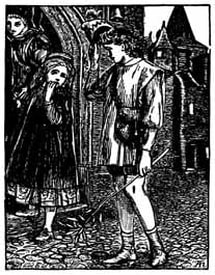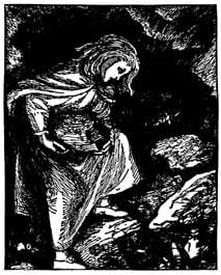|
A young princess finds herself in a kingdom beset by creeping shadows—monsters which lurk far underground. In the darkness below they tunnel endlessly, plotting to one day rise up and take over. Who from the kingdom will challenge this dark foe? Who is worthy to lead the forces of good to beat back the enemy once and for all? This is what fairy tales are made of. We know what's supposed to happen next. A prince will arise, seeking to win the heart of the princess. And what better way to do that than to fashion himself into a fearless, conquering hero who can do anything simply because he believes in himself? It makes perfect sense to our modern ears. As the great philosopher and poet of our age Miley Cyrus once said, “If you believe in yourself anything is possible.” (It’s impossible to find the source of this quote, but I'm sure we will eventually if only we believe in ourselves enough.) But while the prince is off on his own saving the day, one question remains. What's a princess to do in the meantime?  Perhaps Princess Irene can help us out with this question. In the children’s novel The Princess and the Goblin by George MacDonald, Princess Irene is an eight-year-old girl with a penchant for exploring. Her curiosity takes her to all kinds of exciting places, whether that’s getting lost on the rocky slopes of the nearby mountain as daylight begins to fade, or getting lost wandering the endless hallways and staircases of her father’s castle. Her poor nursemaid Lootie. She looks away for one moment and little Princess Irene is gone again, probably getting captured by goblins for all she knows. When Irene comes back one day with a tale about meeting her great-great-grandmother in the attic, Lootie will have none of it and notes that “princesses are in the habit of telling make-believes.” How should a princess act? Lootie has some pretty low expectations. If young princesses are indeed so prone to spreading lies then we can’t really expect better of them. No wonder the prince gets the responsibility of saving the day. Princess Irene, however, continues to defy expectations. She has some very different ideas for how a princess should behave. As she tells Lootie at one point, “Nurse, a princess must not break her word.” You see, Irene has standards. But it's also possible to take her statement the wrong way. Maybe she's saying that it’s perfectly all right for you vulgar peasants to engage in petty trickery and deceit, but as for us royals, we will not stoop to that level. Irene's standards show up again when she gets rather annoyed at Lootie for dismissing her strange story about talking to her great-great-grandmother. MacDonald writes, “Not to be believed does not at all agree with princesses: for a real princess cannot tell a lie.” Well, I guess that settles it. A true royal simply comes from better stock than the rest of us and is therefore naturally virtuous and morally superior. No wonder they’re granted the divine right to rule. No one else is qualified. If there’s anything we’ve learned from history, it’s that kings can be corrupt, noblemen can be far from noble, the clergy can dabble in the diabolical, and the courts can pervert justice in the extreme. These days we expect our heroes to have moral failings and we’re suspicious about anyone held up as morally good. We see the world as a complicated mess of mixed motives and ambiguous outcomes. What separates the good from the bad? That’s a question for ethicists to argue about. It’s hard to see the way forward in a clouded, grey world such as our own. But that’s where stories come in. Stories, when they’re done well, can point us to an ideal without ignoring the troubled reality that we live in. They shine a light on another reality that we can lose sight of and forget to strive for.  Princess Irene is not perfect. What sets her apart as a model to follow is that she never forgets her high calling. She refuses to lower the bar despite her mistakes. Irene gets herself into some trouble, which as I’ve mentioned drives her nursemaid Lootie crazy. On one occasion Irene is caught out of doors after dark, just in time for the goblins to come out of their holes. Thankfully, a twelve-year-old miner named Curdie passes by to help Irene escape from the goblins and return home. Irene “never forgot Curdie, but him she remembered for his own sake, and indeed would have remembered him if only because a princess never forgets her debts until they are paid.” She recognizes that she has a duty to reward the boy for his kindness. That's what princesses do. But going beyond that duty, Irene also just appreciates Curdie for who he is—that's what friends do. How does Irene repay Curdie? As you might expect for a fairy tale, at first the princess promises a kiss to her rescuer. But as Lootie will not tolerate such fraternization, Curdie is content to go home without it. He continues in his quest to discover what nefarious plans the goblins are putting into motion deep underground. That seems to be his mission. So let’s return to our initial question. What’s a princess to do while her rescuer is hard at work saving the kingdom? She should probably go back to her toy rocking horse and try not to get into too much trouble. But that wouldn’t be much of a story. After all, chapter one is entitled “Why the Princess has a Story about her.” As it turns out, Irene repays Curdie by becoming his rescuer. Curdie gets himself captured by goblins in an underground cave and it’s up to Irene to haul away the rocks blocking up the entrance. And so, “with aching back, and bleeding fingers and hands, [Princess Irene] worked on, sustained by the pleasure of seeing the heap slowly diminish and begin to show itself on the opposite side of the fire.” A surprised Curdie, who thinks he’s done for, asks, “What are you doing?” Irene responds matter-of-factly, “Clearing away a huge heap of stones.” At that Curdie exclaims, “There’s a princess!” In other words, thanks for saving my life—and by the way, you’re amazing.  Now that’s impressive for an eight-year-old. Princess Irene seems fairly strong and independent. If she can do that on her own, why would we even need a prince? But before we get ahead of ourselves, let’s think back to that outlandish story Irene told about meeting her great-great-grandmother. Irene insisted the story was true, and so indeed it is. Princess Irene’s great-great-grandmother does in fact show up from time to time living at the top of an otherwise abandoned castle tower. She watches over Irene and provides her with a magical thread to guide her way. It is this thread which leads Irene into the heart of the goblin’s lair so that she can find and rescue Curdie. The same thread guides them home. Curdie cannot see the thread himself, but he decides to trust Irene and follow her nonetheless. As they go, Irene advises him, “Now you must keep by me.” Curdie must trust Irene and Irene must trust the magical thread. Her great-great-grandmother tells her that the thread will lead her home, but that “it may seem to you a very roundabout way indeed, and you must not doubt the thread. Of one thing you may be sure, that while you hold it, I hold it too.” We put a lot of emphasis on independence. Fearlessly self-reliant people are strong. After all, how can you be strong unless you trust in your own strength? But the fact is that we're actually dependent on many things even if we don’t realize it. The goblins, for instance, mockingly refer to humans as “sun-people.” If you haven’t noticed, we are totally dependent on the sun for our survival. Every living thing on the planet is. But the goblins, with their fiercely independent spirit, aren’t so sure they need the sun. One goblin says: “Now light your torches, and come along. What a distinction it is to provide our own light, instead of being dependent on a thing hung up in the air – a most disagreeable contrivance – intended no doubt to blind us when we venture out under its baleful influence! Quite glaring and vulgar, I call it, though no doubt useful to poor creatures who haven’t the wit to make light for themselves!” The goblins live under the strong delusion that they alone are the masters of their own fate. While living in their little underground world they’ve become convinced that they need nothing but their own intelligence to survive. They certainly believe in themselves, don’t they? The goblins look at their torches with satisfaction and ignore the sun, our galaxy’s supreme example of fire and light. Perhaps we could say that a goblin is someone who has spent so long focusing on themselves and their desires and their achievements that they’ve become twisted. They trust nothing but themselves. A goblin keeps his head down, no longer able to look to anything higher than his own nose. A princess, however, has a higher calling. So does a prince, by the way. Now, Curdie the miner is not technically a prince. But he sure acts like one. And no, I don’t mean that he goes around feeling entitled, treating everyone else like servants. That's not what a real prince does. Curdie lives a life of service, looking out for others to the point that he puts himself in danger. Irene does the same on her rescue mission. Author George MacDonald points out that “there is some ground for supposing that Curdie was not a miner only, but a prince as well.” Curdie is a prince not because of his ancestry but because of the virtue he exudes. In an introduction to a more recent edition of The Princess and the Goblin, fantasy author Ursula Le Guin writes, “MacDonald is also stern and clear about what nobility is. It has nothing to do with money or social status. A princess is a girl who behaves nobly; a girl who behaves nobly is a princess.”
What is a princess really? To oversimply matters, a princess is the daughter of a king. She does the noble thing because that’s what she’s been taught by her father. Any girl who keeps her eyes on the standard a princess aims for can be a princess herself. In this case the princess of our story also happens to be the great-great-granddaughter of a queen. Princess Irene’s great-great-grandmother does quite a lot of teaching too, reminding Irene where she should place her trust. Does she believe in herself? To a point, yes. But even more so she believes in the words of the ancient queen. Irene wouldn't have gotten very far without her, or without Curdie for that matter. And Curdie's biggest mistake is thinking he can take on the goblins by himself, which gets him captured. It's only when Curdie and Irene learn to rely on each other that they find their way. Our prince and princess may not always get it right. But despite their failings, they do not lose sight of their mission or the high standard to which they are called. Anyone, royalty or otherwise, can be a prince or a princess. But there is a cost. Only those who can admit when they don't measure up to their calling are the ones most likely to fulfill it. Only those who humble themselves and trust can find the thread again and follow it back home.
Comments
|
David Raphael HilderJoin the conversation as we explore the best there is in fantasy, sci-fi, adventure, and of course, the classics Archives
December 2020
Categories
All
|


